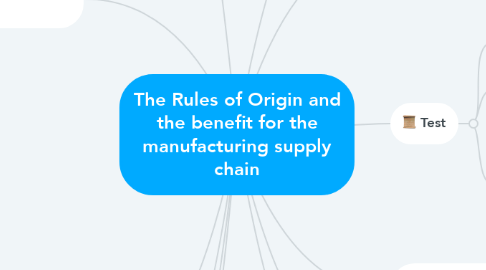
1. are
1.1. Laws
1.2. regulations
1.2.1. used to determine the country
1.2.2. of origin of an imported product
1.3. procedures
2. They are a significant part of
2.1. international trade policy
2.1.1. becuse ROO are needed to
2.1.1.1. properly assess tariffs
2.1.1.2. enforce trade remedies
2.1.1.3. statistical purposes
3. Rules of Origin in U.S. Practice
3.1. The country of origin of an imported product is
3.1.1. defined in U.S. trade laws and customs regulations as the country of:
3.1.1.1. manufacture
3.1.1.2. production
3.1.1.3. growth of any article of foreign
3.1.1.4. origin entering the customs territory of the United States.
3.1.2. and customs regulations as the country of:
4. There are two types of rules of origin:
4.1. Non-preferential ROO
4.1.1. are used to determine the origin of goods imported from countries with which the United States has most-favored-nation (MFN) status
4.1.1.1. they are the principal regulatory tools for accurate assessment of:
4.1.1.1.1. tariffs on imports
4.1.1.1.2. addressing country of origin labeling issues
4.1.1.1.3. qualifying goods for government procurement
4.1.1.1.4. enforcing trade remedy actions and trade sanctions.
4.1.1.1.5. trade sanctions.
4.1.2. origin
4.1.2.1. As a member of the WTO
4.1.2.2. United States must grant mostfavored-nation (MFN) treatment to the products of other WTO member countries
4.1.2.2.1. with respect to tariffs
4.1.2.2.2. and other trade-related measures
4.1.3. Criteria
4.1.3.1. two major criteria apply
4.1.3.1.1. First, goods that are wholly the growth, product, or manufacture of one particular country are attributed to that country.
4.1.3.1.2. Second, when determining origin, CBP takes into account one or more of the following factors:
4.2. Preferential ROO
4.2.1. are used to determine the eligibility of imported goods from U.S. free trade
4.2.2. agreement (FTA) partners and certain developing countries to receive duty-free benefits
4.2.2.1. Preferential ROO schemes vary from agreement to agreement and preference to preference.
4.2.3. under U.S. trade preference programs (
4.2.4. and other special import programs
5. International Commitments
5.1. are designed to conform to the WTO Agreement on Rules of Origin
5.1.1. in which WTO members agreed not to use ROO to pursue trade policy objectives in a manner that would disrupt trade,
5.1.1.1. and to apply them in
5.1.1.1.1. a consistent
5.1.1.1.2. uniform
5.1.1.1.3. impartial
5.1.1.1.4. reasonable manner
6. Test
6.1. “Tariff Shift” Test
6.1.1. may be used to determine whether or not the product qualifies for benefits.
6.2. Technical Test
6.2.1. With certain products, may be used that requires specific processing operations occur in the originating country.
6.3. Local or Regional Value Content Test
6.3.1. is required of many products imported into the United States under FTAs or preference programs
6.3.1.1. stipulates that to receive the tariff benefit
6.3.1.1.1. a product must contain a minimum percentage of domestic value-added
7. Rules of Origin Issues
7.1. Due to their obscure and technical nature
7.1.1. rules of origin frameworks are generally not in the forefront of
7.1.1.1. the debates on trade liberalization
7.1.1.2. or globalization
7.1.1.3. Nevertheless, the role
7.1.1.3.1. is central to the international trading system and trade negotiations.
8. New Characteristics in Rules of Origin
8.1. The United States-Mexico-Canada Agreement (USMCA), which replaces NAFTA
8.1.1. introduced additional requirements for
8.1.1.1. determining country of origin that have not existed in prior U.S. FTAs.
8.1.1.1.1. the agreement introduced requirements for steel and aluminum content
8.1.1.1.2. and labor value content
9. Proliferation of Preferential ROO
9.1. adds new complexities for importers and manufacturers;
9.1.1. thus potentially inserting economic inefficiencies into the
9.1.2. international trading system.
10. Influence of Domestic Stakeholders
10.1. Some domestic industries push for specific ROO to restrict imports while expanding.
11. ROO Interpretation
11.1. Country of origin rulings can be complex, especially when questions on what processes or
11.2. procedures are sufficient for a product to be “substantially transformed” come into play.
11.2.1. , officials must often make these determinations on a case-by-case basis.
12. Global Manufacturing and Rules of Origin
12.1. In an international trading environment in
12.1.1. which a final good is made with parts sourced from
12.1.1.1. multiple countries
12.1.1.2. and may be assembled anywhere in the world,
12.1.1.2.1. some observers suggest that single-country origin determinations are misleading.
